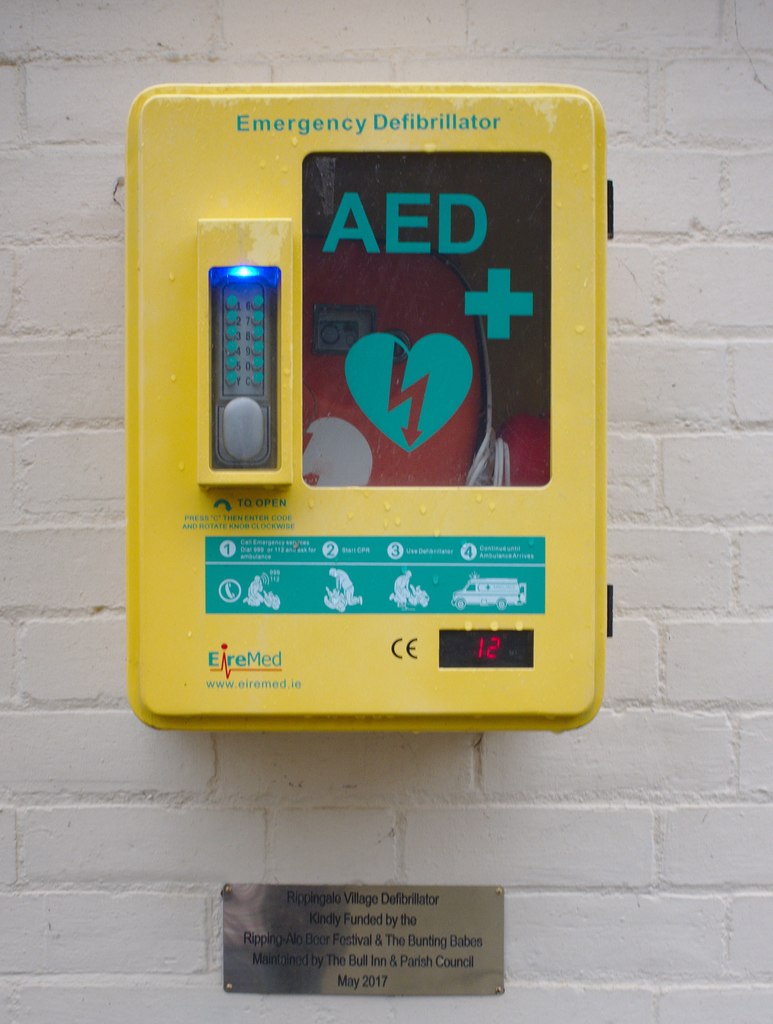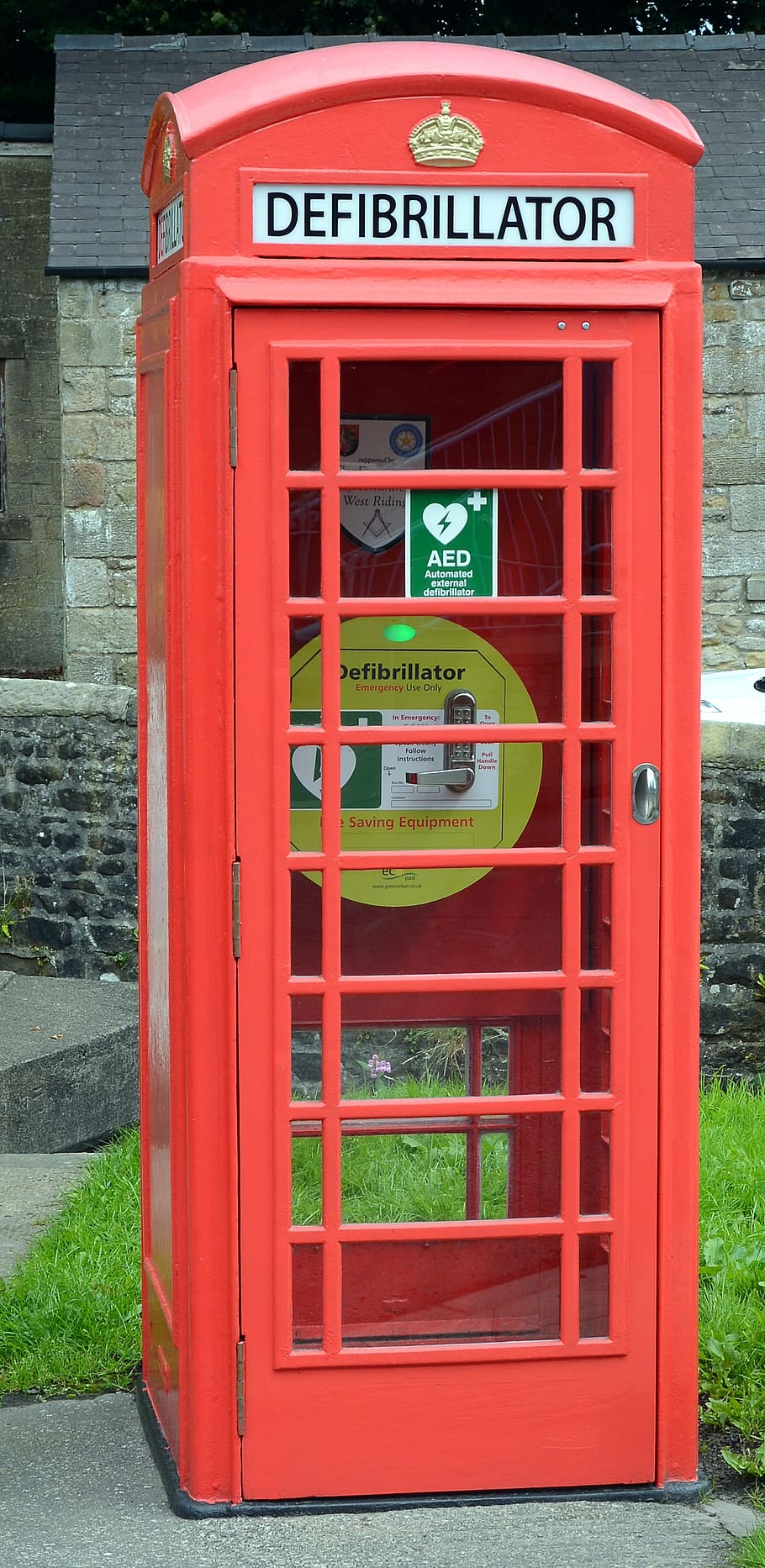Automated external defibrillator AED
|
The AED device is installed at The Bull Inn, which is located near Rippingale in Lincolnshire. |
Contents |
[edit] Introduction
An automated external defibrillator (AED) is a device that responds to an abnormal human cardiac rhythm (or arrhythmia) with the delivery of a regulated pulse of electricity.
[edit] What do AEDs do?
When properly administered, this act of defibrillation may prevent sudden cardiac arrest (SCA) and help the victim’s heart rate return to a regular rhythm. AEDs are portable and designed for first responders who are trained to operate them.
Some AED units can be used by members of the public. They do not require special training and are easy to use. These publicly accessible AED devices are able to assess heart rhythms, provide users with simple audio visual instructions and administer automatic or semi-automatic shocks.
|
This telephone box has been repurposed as an AED station. |
AEDs may be located inside healthcare-related public buildings, such as hospitals, medical clinics, chemists, research facilities and so on. They may also be placed in other locations - including municipal buildings, parks, theatres, restaurants, libraries, places of worship and so on - where people frequently gather.
Some private locations are equipped with AED, such as construction sites where electrocution or overexertion can trigger SCA, particularly where people have underlying or undiagnosed coronary conditions. They may also be placed in office buildings, factories, industrial facilities and so on.
Where multiple AEDs are used, it is advisable to instal one brand of device throughout to simplify maintenance and administration of the equipment. This may also make it easier to design training for staff members who have volunteered to join an organisation’s first aid response team. Professionally trained first responders can sometimes offer guidance on procurement and training related to these devices.
[edit] History
The use of electricity to alter heart rates goes back to the 1700s when a Danish veterinarian and physician experimented with the technique to stop and then start the heart of a chicken. In the 1940s, an American cardiologist named Paul Zoll became involved in research associated with the development of a portable cardiac defibrillator. Having used an external defibrillator to resuscitate two patients, Zoll was able to devise a safe technique in the 1950s.
In the mid-1960s, the Irish physician and cardiologist Frank Pantridge (who was also involved in the development of the modern method of cardiopulmonary resuscitation) refined Zoll’s approach and came up with the first portable defibrillator. Weighing 150 pounds and powered by car batteries, the device was designed to be used by the Belfast ambulance service. A streamlined version (weighing only seven pounds and powered by a miniature capacitor designed by NASA) designed by Pantridge was introduced only a few years later.
By the 1960s, these devices were incorporated into hospitals and emergency response units around the world. However, they did not regularly appear in the UK until the 1990s.
[edit] AED requirements
AEDs have now become fairly common. In the US, AEDs have been required in Federal buildings since 2000. Many UK workplaces - particularly those that are open to the public - have voluntarily invested in this equipment even though employers are not required to do so under the Health and Safety (First-Aid) Regulations 1981.
While AEDs are not required under English law, there can be liability in negligence for failing to take appropriate safety precautions in some workplaces. The 2013 guidance update (amended in 2018) for the The Health and Safety (First-Aid) Regulations 1981 states:
"Where an employer has identified through their needs assessment that they wish to provide an automated external defibrillator (AED) in the workplace, then the Provision and Use of Workplace Equipment Regulations 1998 (PUWER) apply. For the purpose of complying with PUWER in these situations, the employer should provide information and written instructions, for example from the manufacturer of the AED, on how to use it. Fuller training, however, is likely to make the user more confident and is now an integral part of the syllabus for First Aid at Work (FAW) and Emergency First Aid at Work (EFAW) courses."
The Health and Safety Executive (HSE) recommends that employers take into account the public and others on their premises when making their assessment of first aid needs. If the risk assessment identifies a need for an AED, then organisations are advised - but not required - to provide this precautionary measure. For entities that may be concerned about liability issues associated with AEDs, The Social Action, Responsibility and Heroism Act 2015 sets out certain measures to protect people who attempt to assist someone in need.
On matters associated with AEDs, guidance from the Resuscitation Council UK is available. For example, important factors to consider when assessing the risk of cardiac arrest will include the number of people using a facility and the risk of cardiac arrest occurring at the site. The Resuscitation Council UK is one of three organisations in the UK (the others being the Institution of Occupational Safety and Health and the British Heart Foundation) to recommend making AEDs available in workplaces.
[edit] Related articles on Designing Buildings Wiki
- Facilities management.
- First aider.
- Health and safety at work etc act 1974.
- Health and safety for the workplace.
- Health and safety for building design and construction.
- Health and Safety Executive.
- Risk assessment.
- Safety audit.
- Safety in the construction industry.
- Workplace (Health, Safety and Welfare) Regulations 1992.
Featured articles and news
RTPI leader to become new CIOB Chief Executive Officer
Dr Victoria Hills MRTPI, FICE to take over after Caroline Gumble’s departure.
Social and affordable housing, a long term plan for delivery
The “Delivering a Decade of Renewal for Social and Affordable Housing” strategy sets out future path.
A change to adoptive architecture
Effects of global weather warming on architectural detailing, material choice and human interaction.
The proposed publicly owned and backed subsidiary of Homes England, to facilitate new homes.
How big is the problem and what can we do to mitigate the effects?
Overheating guidance and tools for building designers
A number of cool guides to help with the heat.
The UK's Modern Industrial Strategy: A 10 year plan
Previous consultation criticism, current key elements and general support with some persisting reservations.
Building Safety Regulator reforms
New roles, new staff and a new fast track service pave the way for a single construction regulator.
Architectural Technologist CPDs and Communications
CIAT CPD… and how you can do it!
Cooling centres and cool spaces
Managing extreme heat in cities by directing the public to places for heat stress relief and water sources.
Winter gardens: A brief history and warm variations
Extending the season with glass in different forms and terms.
Restoring Great Yarmouth's Winter Gardens
Transforming one of the least sustainable constructions imaginable.
Construction Skills Mission Board launch sector drive
Newly formed government and industry collaboration set strategy for recruiting an additional 100,000 construction workers a year.
New Architects Code comes into effect in September 2025
ARB Architects Code of Conduct and Practice available with ongoing consultation regarding guidance.
Welsh Skills Body (Medr) launches ambitious plan
The new skills body brings together funding and regulation of tertiary education and research for the devolved nation.
Paul Gandy FCIOB announced as next CIOB President
Former Tilbury Douglas CEO takes helm.
UK Infrastructure: A 10 Year Strategy. In brief with reactions
With the National Infrastructure and Service Transformation Authority (NISTA).
























